Bleak midwinter
27 December 2010
‘The English landscape’, said Horace Walpole, ‘is best appreciated framed and glazed’ – a thought never more apt than when snow still covers the trees two weeks after the blizzard, and the ruts on the drive have frozen into unbreakable ridges.
Only a long memory can bring to mind a freeze like this one.
The ground was frozen when the snow fell. The first covering, the transformation of green to ghostlike, the printless revelation of the first morning, was a theme for poetry. The magic doesn’t last long. Is there a more dismal subject for gardeners than the block on all activity while unknown damage is happening unseen?
Better unseen, some argue : at least the
Lining up
14 December 2010
Home from a weekend in Yorkshire deep in snow. The skeletons of the woods are drawn in bold black lines on the swelling white hills. We walked, or trudged, to a gazebo commanding the village of Settrington to sip old champagne* as crisp as the air and enumerate the surrounding hills, dales, farms and copses. The mausoleum of Castle Howard was just distinguishable (it could also have been a big ash or oak) on the skyline to the west.
A brown wall of beech hedge surrounds our hosts' house like the wash-line of a framed watercolour. You are acutely aware of the structures of trees; elongated and aspiring in the middle of a wood, billowing and outreaching on the edges. On a distant hill you see only a dark mass with the bulges of surface tension, like a pool of mercury in the blank white jigsaw puzzle of fields.
Do we think enough about lines and shapes in our gardens? I am reading a small classic of garden design, l'Optique des Jardins, by Robert Mallet, whose
A (completely) New Forest
6 December 2010
It is not only autumn colour that has got into a muddle this year. Pigments have not developed in leaves as we expect, but neither has the abscissic acid that seals off the stalks of leaves and lets them part company with their branch. I am looking out of the window at a Stachyurus praecox, which by now should have turned its special bright parchment yellow and dropped its leaves. They are still green, frost-rimmed but neither colouring nor falling. The only colour is below them where Iris foetidissima has opened its pods and bared its scarlet seeds, among prostrate bergenias, their prone leaves a mournful sight.
Last weekend we were in the New
Seiryu - a Sequence
22 November 2010
Having rashly forecast the chromatic choreography of Seiryu, my favourite Japanese maple (see my Tree of the Month), I must eat my words.
It has not caught fire as it did last year. Instead this slow-motion autumn, with no proper cold nights, although a fair amount of
sunshine, has had the results you see in these dated photos: a slow fade into yellow.
Yellow has been the season's motif.
The field maples have been bulwarks
of bullion along roadsides. Elms, too,
where they still survive. Only oaks
around these fields are deepening in
colour to something approaching
marmalade.
Here is Seiryu over the course of the last
three weeks……..
Simply Come Gardening
19 November 2010
At last the BBC is taking gardening seriously, applying to it the sort of production values that make programmes worth watching more than once - and making the most of Alan Titchmarsh.
His hands-on history of garden fashion that started two weeks ago, with Hatfield House representing the (early) 17th century, is the ideal use of his talents. No other presenter could handle these 90-minute entertainments.
The plan is ambitious but simple - and it works. Alan's so-called 'secrets' are the fundamental vocabulary and grammar of garden design; hedges, parterres, topiary, orchards, eye-catchers, perspective, ha-has, ……. We are shown them in their original context, in macrocosm, in contrast in different settings, and in
This morning
11 November 2010
There was frost first thing, but after breakfast the temperature and the wind both started rising. The sheltering trees started to sigh, then hiss. The last yellow leaves parted from high branches and flew about the garden like bewildered birds. By the cascade, though, cupped in a hollow and protected by evergreens, the only movement was the steady tinkle of water into the shining pond and the arrival, fluttering to earth, of leaves from distant trees.
The cascade has two falls ; the first a mere forearm deep, pouring no faster than wine from a bottle into a little rocky trough. It slithers, then, down a twisting channel in the limestone to a beak of rock that parts it into two gleaming dribbles, to fall from shoulder height between mossy boulders. Two splashy sounds, therefore, in counterpoint.
The pond is crystal clear this morning, floored with the maple leaves that sift down to form a bright mosaic on the
Back to previous Trad's Diaries |
snow insulates plants and the ground from the lowest temperatures. But the thermometer dropped before the insulation arrived.What is trapped in there is not exactly snug.
Winter closed in on an unconsummated autumn. There were so many leaves still on the trees that the snowy woods look strange : carpeted here, spotted there with leaves, some brown, some still green. Nor did the earthworms get even halfway through their work of gathering leaves and tugging them underground. They must have dived for cover in relative warmth when the soil first felt the chill.
It doesn’t do to count your losses prematurely – let alone to cut away plants that still lie half-buried. Spring is too soon to write plants off, too. There will be shoots from the base of things that will surprise you. The leaf-damage is evident enough – from abelia to yucca. I don’t like the look of ballota, camellias, drimys, embothrium, fuchsia, garrya, hoheria, indigofera, lavenders, myrtle, nerium, olearia, penstemons, rhamnus, salvias, trachycarpus,vitex… Some will surprise us, but I fear a lengthy list of disappointments.
And my aspidistra, the one I tried and failed to kill last winter ?
family owns the happiest marriage of French and English garden philosophies, Le Bois des Moutiers, at Varengeville on the coast of Normandy. Mallet makes the point that straight lines can easily be overdone. Vertical ones are like the bars of a cage; horizontal ones exclude us from what lies beyond; straight lines that are nearly but not quite vertical or horizontal make us uneasy, make us uneasy, like a picture that needs straightening. 'Just one misplaced line', he writes, 'can drive you crazy'. It is in winter when lines make up most of the picture that we should study and correct them.
I was leafing through an old brown volume of The Gardener's Magazine of 1830, as one does on locked-in frosty days, to see what preoccupied our fellow-addicts 180 years ago. The first article I opened was the Conductor's (that is John Claudius Loudon's) Notes and Reflections made on a tour from Paris to Germany. He compares the vale of London with the plain of Paris. "The vicinity of Paris is all nakedness and long lines; that of London all clothing and accumulations of houses and trees, with abrupt or circuitous lines. The approaches to Paris on every side are characterized by straight roads, straight rows of trees, straight avenues and alleys, and straight lines in almost every thing. The approaches to London are not characterized by lines; the roads, trees and alleys in woods, are irregular, and neither strikingly crooked and curved, nor always straight." France, he goes on to say, is over-regulated and controlled.
Loudon first visited Paris in 1815, just after Waterloo. Fifteen years later, he says, 'Progress is very considerable'.
* Someone asked. Bruno Paillard 1985
Forest for our son's wedding in Beaulieu parish church, the converted factory of the abbey destroyed by Henry VIII. Beaulieu is one of the loveliest spots in the south of England, isolated on its tidal river by the wilderness of the New Forest. Crossing Beaulieu Heath in deep frost (it was -7° centigrade) was like Hobbema's Holland. They were skating on Hatchet Pond (and have been able to for the past three winters; a hat-trick without precedent, they tell me).
The road to Brockenhurst from Beaulieu winds through a grove of ancient oaks and beeches which were still full of leaf. Even the golden birches, sparkling with rime, were holding their leaves. A fine layer of snow on the upper side of every branch turned wide-spreading trees into dancers gesticulating with out-stretched arms. With such movement and such colour the forest became fantastical: a mythological tapestry, sparklingly clear in some places, veiled in others by patches of low mist, and stained, at sunset, with pink and purple light.
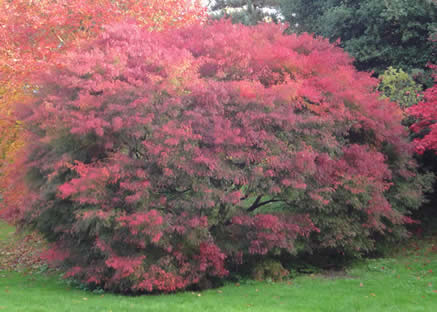
2 November - Acer mono behind left, A. koreana right
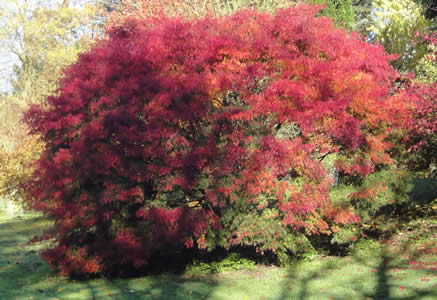
7 November
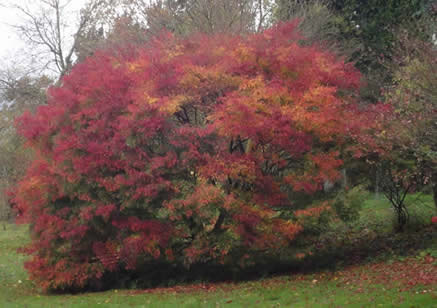
11 November
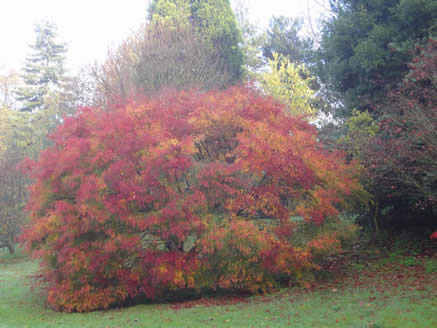
15 November
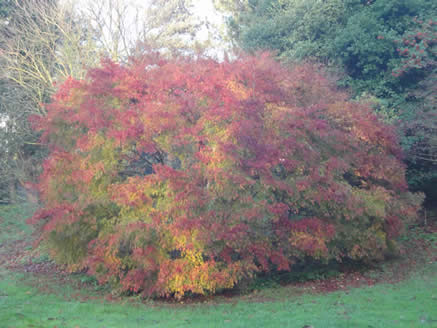
16 November
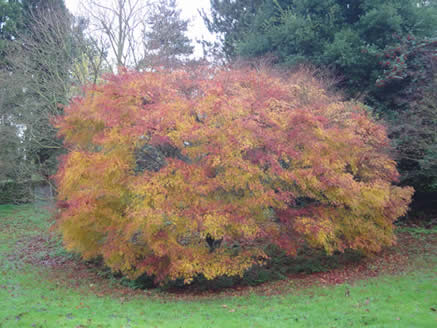
21 November
microcosm, when Alan, with tongue characteristically in cheek, devises and builds a backyard version. The model for perspective may be Vaux-le-Vicomte, but the sample he constructs, with minimum fuss, is bit of trellis, a mirror and a bust taking up no more room than your recycling bins. By the time Alan has draped a bit of honeysuckle and ivy over it you could invite your friends round without shame.
It is far from being just a canter through the usual suspects. Among the designs for a parterre is Tom Stuart-Smith's extraordinary idea of magnifying the venation of a beech leaf to provide a pattern - which in turn inspires Alan to do something similar at his normal express speed with thyme. In one programme he builds a mount, makes cubes of sedum, creates a 'step-over' apple tree hedge ……. and thoroughly enjoys himself.
It seemed odd, I thought, taking Hatfield as the model of a 17th century garden (with due obeisance to Tradescant) while admitting that the whole garden has been created (rather than recreated) in the past fifty years. But it emphasises the truth that a garden is an artefact. If you can't start centuries ago these is no time like the present.
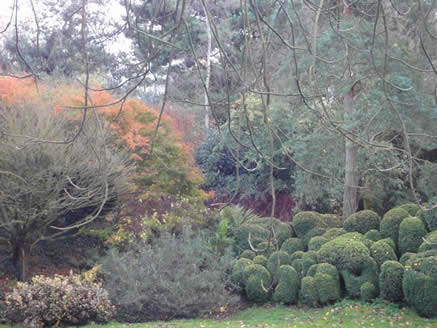
By the pond
bottom. Yellow hosta leaves have melted over a rock into the mirror beside reflected ferns. A willow with leaves as fine as rosemary trails in the water. Drops condensing on the branches high above land portentously in crystal rings that overlap and merge and disappear before they reach the bank. How self-contained and secret this pond life seems ; how removed from the gusts shaking the real world.
|